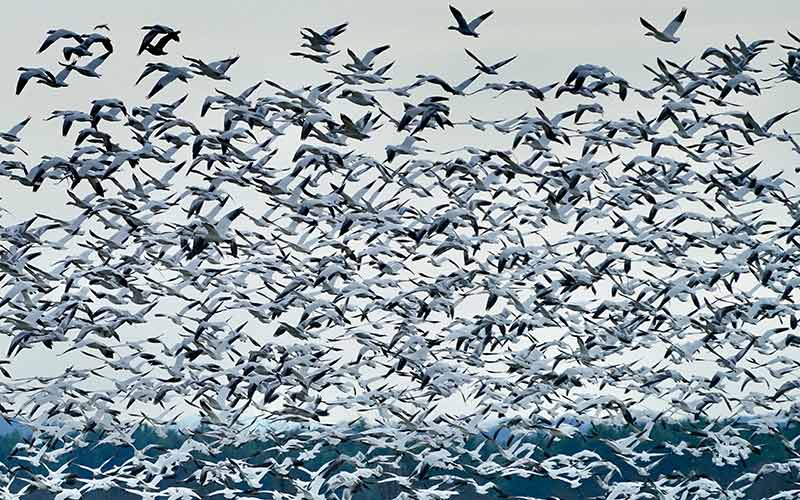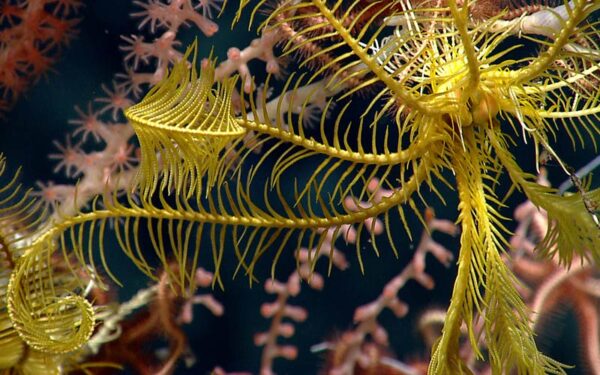
The annual spectacle of Greater Snow Geese migrating through the Champlain Valley depends on the health of wetlands like the ones protected in Vermont’s Dead Creek Wildlife Management Area. Photo: Zack Porter
UPDATE: The Vermont Legislative Study Committee on Wetlands decided against opening up wetlands protections to new exceptions for development and farming. This is a victory for stopping a harmful policy from moving forward, and we’ll keep fighting to expand Vermont’s wetlands with stronger protections for these important ecosystems.
“Drain the swamp.”
It’s a favorite phrase of politicians and pundits, regardless of party affiliation, a folksy way to portray a battle of us versus them, good versus evil.
But the phrase also reveals much about our historical relationship to wetlands, including here in Vermont, where up to half of all wetlands have been eliminated since European arrival.
Today, with ever-present threats from development, draining for farming, and timber harvest, the last thing our vital wetlands need is an attack from our legislators. But some lawmakers seem hell-bent on eliminating the few wetlands that have survived three centuries of filling and draining. And if they have their way, our remaining wetlands could be at risk at the upcoming state legislative session, starting in January.
It’s time to gear up and raise your voice for the under-appreciated, yet critically important values of Vermont’s wetlands
The Workhorse of Natural Communities
For many of us, water simply flows from a faucet, and we think little about it beyond this point of contact. We have lost a sense of respect for the wild river, for the complex workings of a wetland, for the intricate web of life that water supports. – Sandra Postel, The Last Oasis: Facing Water Scarcity
Maligned for centuries as mosquito-filled swamps and impediments to progress, wetlands are, in fact, among the most productive landforms for both people and nature. Wetlands provide critical environmental, public safety, and economic benefits. These include flood resiliency, water quality protection, wildlife and plant habitat, groundwater recharge, erosion control, carbon storage – not to mention recreational opportunities. They filter our drinking water and protect our communities from flooding during high-intensity storm events.
Let’s dig into the details:
- Despite occupying less than ten percent of the land cover of Vermont, wetlands provide critical habitat for 35% of Vermont’s threatened and endangered plant species and 21% of imperiled animals.
- A recent study by The Trust For Public Land found that Vermont’s wetlands provide an estimated $590 per acre annually in flood protection and wildlife habitat, more than three times as much as the next land cover type: deciduous forests.
- Wetlands’ meandering waterways provide natural flood mitigation, slowing and storing stormwater that would otherwise inundate our communities. These benefits will only grow in importance with the escalating impacts of climate change.
- A critical function of wetlands is natural water filtration. Small wetlands adjacent to rivers and streams are especially effective at removing pollutants and sediment. Restoring wetlands in the Vermont portion of the Lake Champlain Basin could achieve 15% of the pollution reduction goals required for the lake by the federal government, according to a study by the Gund Institute at the University of Vermont and The Nature Conservancy.
Pulling the Plug on Wetlands Protections?
Despite all the good that wetlands do for us, however, they continue to be a favorite target of some legislators. At the end of the last legislative session, CLF and our partners successfully defeated attempts to weaken Vermont’s wetland regulations. Yet bad legislation from the previous session often has a way of rearing its ugly head again.
Since the spring, a newly minted Legislative Study Committee on Wetlands has met to assess policy proposals and public desire for changes to the State’s wetland management policies. Vermonters, including farmers and business leaders, largely support leaving wetlands regulations intact, yet some legislators seem intent on ignoring public sentiment and removing protections for them, anyway.
Wetland Laws Need to Be Strengthened, Not Weakened
The reality is, our current wetlands laws don’t go far enough in protecting these vital waters. Current Vermont policy calls for no net loss of wetlands. In other words, a developer could fill in a wetland, but another one must be created elsewhere. But this merely sustains the status quo. State policy should be modernized with a goal of a net gain of wetlands by encouraging protection and restoration.
Rather than expanding exemptions to fill or drain wetlands, policies should focus on promoting their restoration so we can reap the many benefits they provide.
The Legislative Study Committee on Wetlands has one final meeting on December 13 before the start of the new legislative session in January.
As Lake Champlain Lakekeeper, I’m meeting with legislators and state officials to create a brighter future for Vermont’s wetlands – but I can’t do it alone. I need you to make your voice heard, too. Please take action today: tell legislators that our wetlands need stronger, not weaker, protections and that farmers and developers don’t need further exemptions.
Vermont’s wetlands work for us every day. Let’s return the favor.



